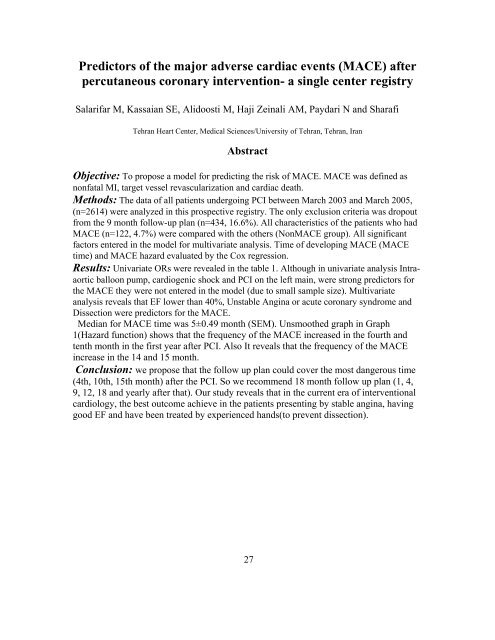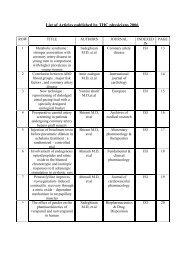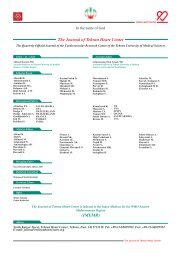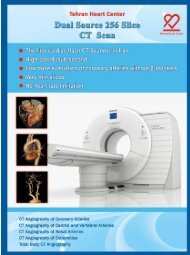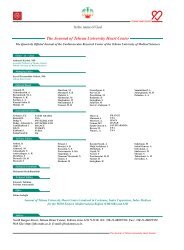Post coronary artery bypass graft surgery
Post coronary artery bypass graft surgery
Post coronary artery bypass graft surgery
You also want an ePaper? Increase the reach of your titles
YUMPU automatically turns print PDFs into web optimized ePapers that Google loves.
Predictors of the major adverse cardiac events (MACE) after<br />
percutaneous <strong>coronary</strong> intervention- a single center registry<br />
Salarifar M, Kassaian SE, Alidoosti M, Haji Zeinali AM, Paydari N and Sharafi<br />
Tehran Heart Center, Medical Sciences/University of Tehran, Tehran, Iran<br />
Abstract<br />
Objective: To propose a model for predicting the risk of MACE. MACE was defined as<br />
nonfatal MI, target vessel revascularization and cardiac death.<br />
Methods: The data of all patients undergoing PCI between March 2003 and March 2005,<br />
(n=2614) were analyzed in this prospective registry. The only exclusion criteria was dropout<br />
from the 9 month follow-up plan (n=434, 16.6%). All characteristics of the patients who had<br />
MACE (n=122, 4.7%) were compared with the others (NonMACE group). All significant<br />
factors entered in the model for multivariate analysis. Time of developing MACE (MACE<br />
time) and MACE hazard evaluated by the Cox regression.<br />
Results: Univariate ORs were revealed in the table 1. Although in univariate analysis Intraaortic<br />
balloon pump, cardiogenic shock and PCI on the left main, were strong predictors for<br />
the MACE they were not entered in the model (due to small sample size). Multivariate<br />
analysis reveals that EF lower than 40%, Unstable Angina or acute <strong>coronary</strong> syndrome and<br />
Dissection were predictors for the MACE.<br />
Median for MACE time was 5±0.49 month (SEM). Unsmoothed graph in Graph<br />
1(Hazard function) shows that the frequency of the MACE increased in the fourth and<br />
tenth month in the first year after PCI. Also It reveals that the frequency of the MACE<br />
increase in the 14 and 15 month.<br />
Conclusion: we propose that the follow up plan could cover the most dangerous time<br />
(4th, 10th, 15th month) after the PCI. So we recommend 18 month follow up plan (1, 4,<br />
9, 12, 18 and yearly after that). Our study reveals that in the current era of interventional<br />
cardiology, the best outcome achieve in the patients presenting by stable angina, having<br />
good EF and have been treated by experienced hands(to prevent dissection).<br />
27


